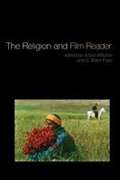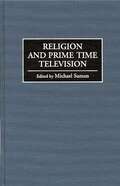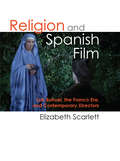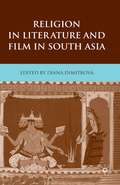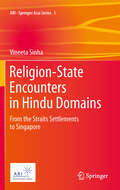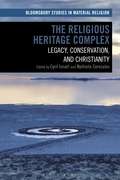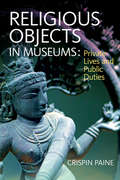- Table View
- List View
Religion and Drama in Early Modern England: The Performance of Religion on the Renaissance Stage
by Elizabeth WilliamsonOffering fuller understandings of both dramatic representations and the complexities of religious culture, this collection reveals the ways in which religion and performance were inextricably linked in early modern England. Its readings extend beyond the interpretation of straightforward religious allusions and suggest new avenues for theorizing the dynamic relationship between religious representations and dramatic ones. By addressing the particular ways in which commercial drama adapted the sensory aspects of religious experience to its own symbolic systems, the volume enacts a methodological shift towards a more nuanced semiotics of theatrical performance. Covering plays by a wide range of dramatists, including Shakespeare, individual essays explore the material conditions of performance, the intricate resonances between dramatic performance and religious ceremonies, and the multiple valences of religious references in early modern plays. Additionally, Religion and Drama in Early Modern England reveals the theater's broad interpretation of post-Reformation Christian practice, as well as its engagement with the religions of Islam, Judaism and paganism.
Religion and Drama in Early Modern England: The Performance of Religion on the Renaissance Stage
by Elizabeth WilliamsonOffering fuller understandings of both dramatic representations and the complexities of religious culture, this collection reveals the ways in which religion and performance were inextricably linked in early modern England. Its readings extend beyond the interpretation of straightforward religious allusions and suggest new avenues for theorizing the dynamic relationship between religious representations and dramatic ones. By addressing the particular ways in which commercial drama adapted the sensory aspects of religious experience to its own symbolic systems, the volume enacts a methodological shift towards a more nuanced semiotics of theatrical performance. Covering plays by a wide range of dramatists, including Shakespeare, individual essays explore the material conditions of performance, the intricate resonances between dramatic performance and religious ceremonies, and the multiple valences of religious references in early modern plays. Additionally, Religion and Drama in Early Modern England reveals the theater's broad interpretation of post-Reformation Christian practice, as well as its engagement with the religions of Islam, Judaism and paganism.
Religion and Film: An Introduction
by Melanie WrightFrom silent films to contemporary blockbusters, religion has always proved a popular theme for the cinema. At the same time, aspects of film-watching are often described as 'religious', while particular films clearly have influenced religious thinking and polemic. However, all too often the encounter between religion and film is discussed from narrowly confessional perspectives, so that the field has long been dominated by the question of a film's fidelity to a religious text or worldview, or its value as a tool in ministry and mission. Such an apologetic approach to the discussion of film and religion is disappointingly limited and parochial.'Religion and Film: An Introduction' seeks to redress the balance. After reviewing current trends in the study of religion and film, Melanie J Wright argues for a new, holistic approach that draws on work from cultural studies, religious studies and film studies alike, and that at last brings to the sophisticated medium of film the multitextured analysis that it deserves. She argues that the given 'meanings' of any film are not fixed by, or encoded in, its textual organisation, but are rather bound up with its varied interpretation by viewers in specific contexts. In a departure from existing treatments of the subject, proper attention is paid to the idea that, in considering and assessing a film's significance, the differing religious and cultural locales in which a film is seen are at least as important as its other features.A broad and religiously diverse range of films including 'The Ten Commandments', 'La Passion de Jeanne d'Arc', 'Kadosh', 'Lagaan', ''My Son the Fanatic', 'Keeping the Faith', 'The Wicker Man' and Mel Gibson's 'The Passion of The Christ' is discussed from four main perspectives: narrative, style, cultural context, and reception. The author looks at varied screen representations of religion; at films shaped by strong convictions about the place of religion in society; and at the roles that audiences play as consumers of film. With its novel emphases, and clear and well organised discussion of the whole field, the book will have strong appeal to students as well as general readers interested in all aspects of the inter-relationship of religion and the cinema.'Melanie Wright not only provides fascinating discussion of a range of important movies, but also moves the fledgling field of 'religion and film' to the next stage by drawing attention to concepts, questions and themes that undergird this exciting interdisciplinary endeavour. Religion and Film: An Introduction is a must-read for anyone interested in the integral relationship between religion and film in Hollywood and beyond. It will also prove an indispendable text for undergraduates and their teachers.'- Adele Reinhartz, Associate Vice-President of Research, and Professor of Religion & Classics, University of Ottawa'The developing field of religion and film is very new and encourages a wide range of different interests and approaches, as Melanie Wright rightly acknowledges in this substantial contribution to film and religion studies. The whole area has not yet developed very far, is something of a hodge-podge, and to a certain degree we do not yet know what we are doing. By selecting a particular systematic approach to religion and film – which incorporates an analysis of narrative, style, content and reception – Wright makes a great step forward for the whole field. Her cultural studies approach to the topic proposes a clearly defined solution to the subject's fragmentariness: a challenge that is long overdue. Moreover, the account she gives of each film that she considers is thorough, fascinating and enlightening.'- William L Blizek, Professor of Philosophy and Religion, University of Nebraska at Omaha, and Editor of The Journal of Religion and Film
The Religion and Film Reader
by Jolyon Mitchell S. Brent PlateEdited by leading experts in the field, The Film and Religion Reader brings together the key writings in this exciting and dynamic discipline. In over sixty interviews, essays and reviews from numerous directors, film critics and scholars, this eagerly anticipated anthology offers the most complete survey of this emerging field to date.
Religion and Prime Time Television (Non-ser.)
by Michael SumanHow is religion portrayed on prime time entertainment television and what effect does this have on our society? This book brings together the opinions of all the important factions involved in this important public policy debate, including religious figures (Christians, Jews, Muslims, Buddhists, and Freethinkers—liberal and conservative), academics, media critics and journalists, and representatives of the entertainment industry. The debate provides contrasting views on how much and what type of religion should be on entertainment television and what relationship this has with the health of our society. Many contributors also offer strategies for how to reform the present situation. This is an important work that delineates the debate for the layperson as well as researchers, scholars, and policymakers.
Religion and Spanish Film: Luis Buñuel, the Franco Era, and Contemporary Directors
by Elizabeth ScarlettTreatments of religion found in Spanish cinema range from the pious to the anticlerical and atheistic, and every position in between. In a nation with a strong Catholic tradition, resistance to and rebellion against religious norms go back almost as far as the notion of “Sacred Spain.” Religion and Spanish Film provides a sustained study of the religious film genre in Spain practiced by mainstream Francoist film makers, the evolving iconoclasm, parody, and reinvention of the Catholic by internationally renowned Surrealist Luis Buñuel, and the ongoing battle of the secular versus the religious manifested in critically and popularly acclaimed directors Pedro Almodóvar, Julio Medem, Alejandro Amenábar, and many others. The conflicted Catholicism that emerges from examining religious themes in Spanish film history shows no sign of ending, as unresolved issues from the Civil War and Franco dictatorship, as well as the unsettled relationship between Church and State, continue into the present.
Religion in Literature and Film in South Asia
by Diana DimitrovaThis innovative, interdisciplinary collection of essays by scholars based in Europe and the United States offers stimulating approaches to the role played by religion in present-day South Asia.
Religion in Museums: Global and Multidisciplinary Perspectives
by Gretchen Buggeln Crispin Paine S. Brent PlateBringing together scholars and practitioners from North America, Europe, Russia, and Australia, this pioneering volume provides a global survey of how museums address religion and charts a course for future research and interpretation. Contributors from a variety of disciplines and institutions explore the work of museums from many perspectives, including cultural studies, religious studies, and visual and material culture. Most museums throughout the world – whether art, archaeology, anthropology or history museums – include religious objects, and an increasing number are beginning to address religion as a major category of human identity. With rising museum attendance and the increasingly complex role of religion in social and geopolitical realities, this work of stewardship and interpretation is urgent and important. Religion in Museums is divided into six sections: museum buildings, reception, objects, collecting and research, interpretation of objects and exhibitions, and the representation of religion in different types of museums. Topics covered include repatriation, conservation, architectural design, exhibition, heritage, missionary collections, curation, collections and display, and the visitor's experience. Case studies provide comprehensive coverage and range from museums devoted specifically to the diversity of religious traditions, such as the State Museum of the History of Religion in St Petersburg, to exhibitions centered on religion at secular museums, such as Hajj: Journey to the Heart of Islam, at the British Museum.
Religion in Museums: Global and Multidisciplinary Perspectives
by Gretchen Buggeln Crispin Paine S. Brent PlateBringing together scholars and practitioners from North America, Europe, Russia, and Australia, this pioneering volume provides a global survey of how museums address religion and charts a course for future research and interpretation. Contributors from a variety of disciplines and institutions explore the work of museums from many perspectives, including cultural studies, religious studies, and visual and material culture. Most museums throughout the world – whether art, archaeology, anthropology or history museums – include religious objects, and an increasing number are beginning to address religion as a major category of human identity. With rising museum attendance and the increasingly complex role of religion in social and geopolitical realities, this work of stewardship and interpretation is urgent and important. Religion in Museums is divided into six sections: museum buildings, reception, objects, collecting and research, interpretation of objects and exhibitions, and the representation of religion in different types of museums. Topics covered include repatriation, conservation, architectural design, exhibition, heritage, missionary collections, curation, collections and display, and the visitor's experience. Case studies provide comprehensive coverage and range from museums devoted specifically to the diversity of religious traditions, such as the State Museum of the History of Religion in St Petersburg, to exhibitions centered on religion at secular museums, such as Hajj: Journey to the Heart of Islam, at the British Museum.
Religion, Literature and the Imagination: Sacred Worlds (Continuum Literary Studies)
by Mark Knight Louise LeeThe study of religion and literature continues to go from strength to strength - this collection of essays offers a dynamic, lively and provocative contribution to the field and aims to map out new directions it might take. By returning to foundational questions regarding the relation between words and worlds and the parameters of the sacred, the essays explore different ways of using interdisciplinary resources to open up our understanding of religion and literature. Contributions from some of the leading voices in the field unite to offer an important exploration of the possible worlds that the study of religion and literature imagines.
Religion, Literature and the Imagination: Sacred Worlds (Continuum Literary Studies)
by Mark Knight Louise LeeThe study of religion and literature continues to go from strength to strength - this collection of essays offers a dynamic, lively and provocative contribution to the field and aims to map out new directions it might take. By returning to foundational questions regarding the relation between words and worlds and the parameters of the sacred, the essays explore different ways of using interdisciplinary resources to open up our understanding of religion and literature. Contributions from some of the leading voices in the field unite to offer an important exploration of the possible worlds that the study of religion and literature imagines.
Religion of the Gods: Ritual, Paradox, and Reflexivity
by Kimberley Christine PattonIn many of the world's religions, both polytheistic and monotheistic, a seemingly enigmatic and paradoxical image is found--that of the god who worships. Various interpretations of this seeming paradox have been advanced. Some suggest that it represents sacrifice to a higher deity. Proponents of anthropomorphic projection say that the gods are just "big people" and that images of human religious action are simply projected onto the deities. However, such explanations do not do justice to the complexity and diversity of this phenomenon. In Religion of the Gods, Kimberley C. Patton uses a comparative approach to take up anew a longstanding challenge in ancient Greek religious iconography: why are the Olympian gods depicted on classical pottery making libations? The sacrificing gods in ancient Greece are compared to gods who perform rituals in six other religious traditions: the Vedic gods, the heterodox god Zurvan of early Zoroastrianism, the Old Norse god Odin, the Christian God and Christ, the God of Judaism, and Islam's Allah. Patton examines the comparative evidence from a cultural and historical perspective, uncovering deep structural resonances while also revealing crucial differences. Instead of looking for invisible recipients or lost myths, Patton proposes the new category of "divine reflexivity." Divinely performed ritual is a self-reflexive, self-expressive action that signals the origin of ritual in the divine and not the human realm. Above all, divine ritual is generative, both instigating and inspiring human religious activity. The religion practiced by the gods is both like and unlike human religious action. Seen from within the religious tradition, gods are not "big people," but other than human. Human ritual is directed outward to a divine being, but the gods practice ritual on their own behalf. "Cultic time," the symbiotic performance of ritual both in heaven and on earth, collapses the distinction between cult and theology each time ritual is performed. Offering the first comprehensive study and a new theory of this fascinating phenomenon, Religion of the Gods is a significant contribution to the fields of classics and comparative religion. Patton shows that the god who performs religious action is not an anomaly, but holds a meaningful place in the category of ritual and points to a phenomenologically universal structure within religion itself.
Religion-State Encounters in Hindu Domains: From the Straits Settlements to Singapore (ARI - Springer Asia Series #1)
by Vineeta SinhaThe historical and empirical project presented here is grounded in a desire to theorize ‘religion-state’ relations in the multi-ethnic, multi-religious, secular city-state of Singapore. The core research problematic of this project has emerged out of the confluence of two domains, ‘religion, law and bureaucracy’ and ‘religion and colonial encounters.’ This work has two core objectives: one, to articulate the actual points of engagement between institutions of religion and the state, and two, to identify the various processes, mechanisms and strategies through which relations across these spheres are sustained. The thematic foundations of this book rest on disentangling the complex interactions between religious communities, individuals and the various manifestations of the Singapore state, relationships that are framed within a culture of bureaucracy. This is accomplished through a scrutiny of Hindu domains on the island nation-state, from her identity as part of the Straits Settlements to the present day. The empirical and analytical emphases of this book rest on the author's engagement with the realm of Hinduism as it is conceived, structured, framed and practiced within the context of a strong state in Singapore today. Ethnographically,the book focusses on Hindu temple management and the observance of Hindu festivals and processions, enacted within administrative and bureaucratic frames.
Religious Art in France of the Thirteenth Century (Dover Fine Art, History Of Art Series)
by Emile MâleThe art in medieval cathedrals, in addition to its profound aesthetic appeal, told unlettered churchgoers a series of morality tales. From divine creation to the lives of the saints, the stone sculpture and stained glass windows provided dramatic illustrations of the key elements of Christian doctrine. Unfortunately, the true meaning of these religious artworks was gradually obscured by time. In 1913, however, this brilliant study appeared, clarifying and illuminating the original ideas and concepts behind the sacred art of the Middle Ages.
Religious Education: A Conceptual and Interdisciplinary Approach for Secondary Level
by Clive ErrickerThe role of Religious Education in secondary schools is the subject of national and international debate. This book examines the current debates surrounding RE and puts forward a new approach to teaching the subject that is non-faith based and focused on conceptual enquiry and the development of a clear pedagogy. The book is based on the Living Difference learning model developed in Hampshire and adopted in other parts of the UK, which is sparking international discussion and provides an effective approach to implementing the new secondary curriculum. The chapters include examinations of: religious education and the curriculum an interdisciplinary approach to religious education the significance of pedagogy and learners’ development planning, progression, assessment and delivery specific case studies and examples of good practice in schools theoretical grounding and the future of RE the effects of globalisation, post-modernity and multiculturalism. Providing a basis for developing thinking about Religious Education, its place in the curriculum and how it can be delivered effectively in schools, this book is essential reading for tutors, students and teachers.
Religious Education: A Conceptual and Interdisciplinary Approach for Secondary Level
by Clive ErrickerThe role of Religious Education in secondary schools is the subject of national and international debate. This book examines the current debates surrounding RE and puts forward a new approach to teaching the subject that is non-faith based and focused on conceptual enquiry and the development of a clear pedagogy. The book is based on the Living Difference learning model developed in Hampshire and adopted in other parts of the UK, which is sparking international discussion and provides an effective approach to implementing the new secondary curriculum. The chapters include examinations of: religious education and the curriculum an interdisciplinary approach to religious education the significance of pedagogy and learners’ development planning, progression, assessment and delivery specific case studies and examples of good practice in schools theoretical grounding and the future of RE the effects of globalisation, post-modernity and multiculturalism. Providing a basis for developing thinking about Religious Education, its place in the curriculum and how it can be delivered effectively in schools, this book is essential reading for tutors, students and teachers.
The Religious Film: Christianity and the Hagiopic (New Approaches to Film Genre)
by Pamela GraceFrom The Gospel According to Matthew to Jesus Christ Superstar, from The Passion of Joan of Arc to The Last Temptation of Christ and Jesus of Montreal, The Religious Film captures the glory, gore, and centrality of this important genre. A short, accessible introduction to religious film, exploring the genre as spectacle, as musical, and as controversy Examines the historical, cultural and critical background for religious films from the silent era through to the present day Introduces the complexities and characteristics of this iconic genre of film, including common sounds and images, and the values that most traditional films of this kind uphold
The Religious Heritage Complex: Legacy, Conservation, and Christianity (Bloomsbury Studies in Material Religion)
by Cyril Isnart Nathalie CerezalesThe Religious Heritage Complex examines religious institutions and heritage-making, arguing that the relationship between the two is not as clear-cut as some might think. In fact, the authors show that religious activity has always combined care for the past with conscious practices of heritage-making, which they term “the religious heritage complex.”The book considers the ways patrimony, religion, and identity interact in different contexts worldwide and how religious objects and sites function as identity. It focuses on heritage-making as a religious and material activity for the groups in charge of a religious inheritance, and considers heritage activities as a form of spiritual renewal and transmission. Case studies explore Christian, Afro-Brazilian, Muslim, and Buddhist traditions located in Europe, the Americas, Africa, and Asia. By investigating the longstanding and tightly-enmeshed connections that weave together religion and cultural heritage, this book allows us to think through the ambiguity of religious heritage.
The Religious Heritage Complex: Legacy, Conservation, and Christianity (Bloomsbury Studies in Material Religion)
The Religious Heritage Complex examines religious institutions and heritage-making, arguing that the relationship between the two is not as clear-cut as some might think. In fact, the authors show that religious activity has always combined care for the past with conscious practices of heritage-making, which they term “the religious heritage complex.”The book considers the ways patrimony, religion, and identity interact in different contexts worldwide and how religious objects and sites function as identity. It focuses on heritage-making as a religious and material activity for the groups in charge of a religious inheritance, and considers heritage activities as a form of spiritual renewal and transmission. Case studies explore Christian, Afro-Brazilian, Muslim, and Buddhist traditions located in Europe, the Americas, Africa, and Asia. By investigating the longstanding and tightly-enmeshed connections that weave together religion and cultural heritage, this book allows us to think through the ambiguity of religious heritage.
Religious Imaging in Millennialist America: Dark Gnosis
by Ashley CrawfordAshley Crawford investigates how such figures as Ben Marcus, Matthew Barney, and David Lynch—among other artists, novelists, and film directors—utilize religious themes and images via Christianity, Judaism, and Mormonism to form essentially mutated variations of mainstream belief systems. He seeks to determine what drives contemporary artists to deliver implicitly religious imagery within a ‘secular’ context. Particularly, how religious heritage and language, and the mutations within those, have impacted American culture to partake in an aesthetic of apocalyptism that underwrites it.
The Religious Life of Dress: Global Fashion and Faith (Dress, Body, Culture)
by Lynne HumeFrom clothing to the painted and scarified nude body, through overt, public display or esoteric symbols known only to the initiated, dress can convey information about beliefs, faith, identity, power, agency, resistance, and fashion. Taking a 'senses' approach, Hume's engaging account takes into consideration the look, smell, feel, touch and sound of religious apparel, the 'smells and bells' of dress and its accoutrements, as well as the emotions evoked by donning religious garb. The book's global perspective provides wide-ranging, yet detailed, coverage of religious dress, from the history and meaning of the simple 'no-frills' attire of the Anabaptists to the power structure displayed in the elaborate fabrics and colours of the Roman Catholic Church; Hume examines the 2,500 year-old tradition of Buddhist robes, the nudity of India's holy men, and much more. With chapters on Sufism, Vodou, modern Pagans, as well as painted and tattooed indigenous and modern Western bodies, the reader is swept along on a sensual journey of the sight, sound, smell and feel of wearing religion. Unique in its field, this intriguing and informative anthropological approach to the body and dress is an essential read for students of Anthropology, Anthropology of Dress, Sociology, Fashion and Textiles, Culture and Dress, Body and Culture and Cultural Studies.
The Religious Life of Dress: Global Fashion and Faith (Dress, Body, Culture)
by Lynne HumeFrom clothing to the painted and scarified nude body, through overt, public display or esoteric symbols known only to the initiated, dress can convey information about beliefs, faith, identity, power, agency, resistance, and fashion. Taking a 'senses' approach, Hume's engaging account takes into consideration the look, smell, feel, touch and sound of religious apparel, the 'smells and bells' of dress and its accoutrements, as well as the emotions evoked by donning religious garb. The book's global perspective provides wide-ranging, yet detailed, coverage of religious dress, from the history and meaning of the simple 'no-frills' attire of the Anabaptists to the power structure displayed in the elaborate fabrics and colours of the Roman Catholic Church; Hume examines the 2,500 year-old tradition of Buddhist robes, the nudity of India's holy men, and much more. With chapters on Sufism, Vodou, modern Pagans, as well as painted and tattooed indigenous and modern Western bodies, the reader is swept along on a sensual journey of the sight, sound, smell and feel of wearing religion. Unique in its field, this intriguing and informative anthropological approach to the body and dress is an essential read for students of Anthropology, Anthropology of Dress, Sociology, Fashion and Textiles, Culture and Dress, Body and Culture and Cultural Studies.
Religious Objects in Museums: Private Lives and Public Duties
by Crispin PaineIn the past, museums often changed the meaning of icons or statues of deities from sacred to aesthetic, or used them to declare the superiority of Western society, or simply as cultural and historical evidence. The last generation has seen faith groups demanding to control 'their' objects, and curators recognising that objects can only be understood within their original religious context. In recent years there has been an explosion of interest in the role religion plays in museums, with major exhibitions highlighting the religious as well as the historical nature of objects.Using examples from all over the world, Religious Objects in Museums is the first book to examine how religious objects are transformed when they enter the museum, and how they affect curators and visitors. It examines the full range of meanings that religious objects may bear - as scientific specimen, sacred icon, work of art, or historical record. Showing how objects may be used to argue a point, tell a story or promote a cause, may be worshipped, ignored, or seen as dangerous or unlucky, this highly accessible book is an essential introduction to the subject.
Religious Objects in Museums: Private Lives and Public Duties
by Crispin PaineIn the past, museums often changed the meaning of icons or statues of deities from sacred to aesthetic, or used them to declare the superiority of Western society, or simply as cultural and historical evidence. The last generation has seen faith groups demanding to control 'their' objects, and curators recognising that objects can only be understood within their original religious context. In recent years there has been an explosion of interest in the role religion plays in museums, with major exhibitions highlighting the religious as well as the historical nature of objects.Using examples from all over the world, Religious Objects in Museums is the first book to examine how religious objects are transformed when they enter the museum, and how they affect curators and visitors. It examines the full range of meanings that religious objects may bear - as scientific specimen, sacred icon, work of art, or historical record. Showing how objects may be used to argue a point, tell a story or promote a cause, may be worshipped, ignored, or seen as dangerous or unlucky, this highly accessible book is an essential introduction to the subject.
The Religious Philosophy of Simone Weil: An Introduction (Library of Modern Religion)
by Lissa McCulloughThe French philosopher Simone Weil (1909-1943), a contemporary of Simone de Beauvoir and Jean-Paul Sartre, remains in every way a thinker for our times. She was an outsider, in multiple senses, defying the usual religious categories: at once atheistic and religious; mystic and realist; sceptic and believer. She speaks therefore to the complex sensibilities of a rationalist age. Yet despite her continuing relevance, and the attention she attracts from philosophy, cultural studies, feminist studies, spirituality and beyond, Weil's reflections can still be difficult to grasp, since they were expressed in often inscrutable and fragmentary form. Lissa McCullough here offers a reliable guide to the key concepts of Weil's religious philosophy: good and evil, the void, gravity, grace, beauty, suffering and waiting for God. In addressing such distinctively contemporary concerns as depression, loneliness and isolation, and in writing hauntingly of God's voluntary 'nothingness', Weil's existential paradoxes continue to challenge and provoke. This is the first introductory book to show the essential coherence of her enigmatic but remarkable ideas about religion.


